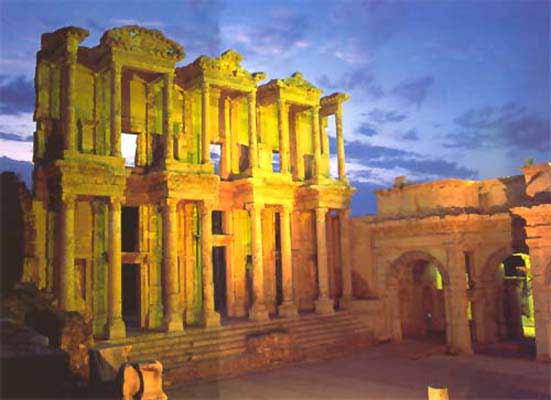220 km north of Bodrum near the village of Selçuk. Ephesus is the most popular ancient site in south weastern Turkey, and deservedly so. Many acres of carefully excavated ruins present an unparalleled recreation of ancient splendour. This once thriving metropolis had. as many as 250,000 inhabitants, and its ruins require at least a full day, to appreClate. With its excellent seaside location and the financial favours of many rulers, Ephesus became the most impornant city of Asia Minor throughout several civilizations.
The Greeks founded Ephesus in the llth Century B.C. It quickly became the centre of culture, commerce and power, the home of enough progressive ideas for some historians to call it the base of Western Civilization. In the 6th Century B.C. the centre of power shifted to Athens, but Ephesus still prospered.
A succession of rulers from different empires conquered the city and added to its riches, in cluding Alexander the Great in the 4th Century B.C. Alexander's successor, Lysimachus, recognized the danger of silt from the River Cayster filling up the harbour so he moved the city inland. The Romans gained control of Ephesus in the 2nd Century, B.C. establishing it as their Asian capital. During Augustus' reign (34-3lB.C.) Ephesus began a 200 year period of prominence as the commercial and banking centre of Western Anatolia. The decline of the Roman Empire coincided with everincreasing amounts of silt in the harbour. Nero and Hadrian each tried to halt the effect of the silt by diverting the river. The inevitable happened, however, and the sea has now retreated over five km from the original pon of Ephesus. The centre of habitation moved to the present town of Selçuk, where present-day dwellings have replaced ancient structures. Subject to earthquakes and natural burial, Ephesus remained hidden until the English engineer J.T. Wood began searching for the Temple of Anemis in 1863, one of the Seven Wonders of the Ancient World. His search was successful, an Austrian team began excavating in 1895. Excavation continues to this day. A guide at the site tells visitors that if work were to continue at its present Ephesus rate, it would take another 200 years to uncover all Ephesus.Visitors to Ephesus should first stop at the museum in Selçuk, which houses all the removable discoveries found after the Second World War (museums in Vienna and Izmir contain previous findings). Included are two statues of the many breasted (37, to be exact ) Goddess Artemis Ephesia, and a fine bronze statue of Eros riding a dolphin. Nothing but the foundation and a single column remain at Ephesus to suggest the wonder of the Temple of Artemis, but much of the rest of Ephesus is remarkably intact.Visitors here often have trouble saying what feature impressed them the most. Was it the 25,000 seat theatre, the elaborate facade of the Colsus Library, or the graceful reconstruction of the Temple of Hadrian? For many it's the smooth marble streets, complete with chariot grooves. Just south of Ephesus lies another popular attraction, the House of the Virgin Mary. Legend has it that Chirst entrusted care of His mother to the disciple John, who brought her to Ephesus in 37 A.D. The location of her house remained a mystery until 1891, when Catherine Emmerich published an account of her visions about Mary. Never having set foot in Turkey, this German woman is said to have described the precise location of the Virgin's, house on a hillside near Ephesus. A search party found the remains of a house there which conformed exactly to her description, and in 1892 the Vatican declared the site an official place of pilgrimage. Since then many worshippers and tourists alike have visited the humble house/chapel which was erected there in 1951.
|


